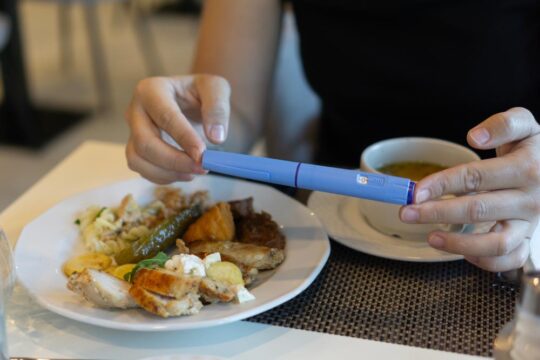Advertisment
Hypertension – Treat to target with multiple agents

by Christine Clark FRPharmS – In association with A.Menarini Pharmaceuticals Ireland Ltd. and Daiichi Sankyo Pharmaceuticals Ireland Ltd. Hypertension is a long-term condition for which an individual will require treatment over a period of years. The majority of patients will not respond adequately to monotherapy and a combination of drugs is usually required, but this can lead to complex and burdensome regimens. The use of an agent, such as olmesartan, that is effective, well-tolerated and available in a range of doses and combinations, enables a consistent treatment strategy to be followed.
It has been estimated that in the Republic of Ireland in 2010 nearly one million adults over the age of 45 years had hypertension. Of these, 356,000 had diagnosed hypertension and 595,000 had undiagnosed hypertension.1 Thus, for every three adults aged 45+ years with diagnosed hypertension there are approximately five adults aged 45+ years with undiagnosed hypertension.1 The number of adults with hypertension is expected to increase between 2010 and 2020 and this will have significant implications for the individuals concerned and for the health and social care system.1 One major implication is the need for a systematic approach to the management of hypertension using effective and well-tolerated agents and products that enable rational prescribing and promote continued adherence.
Hypertension is strongly correlated with the risk of stroke and with an array of other cardiovascular diseases.2 Treatment of hypertension is associated with reduced risks of cardiovascular morbidity and mortality. A meta-analysis of 61 studies involving a total of one million adults indicated that for every 2mmHg decrease in systolic blood pressure there was a 7% reduction in the risk of cardiovascular mortality and a 10% reduction in the risk of stroke mortality.2 However, the majority of patients are not systematically ‘treated to target’ – indeed, the recent Survey of Lifestyle, Attitudes and Nutrition in Ireland showed that about 70% of those receiving treatment for hypertension were not controlled to blood pressure levels below 140/90 mmHg.3
Part of the problem is that the majority of patients with hypertension cannot be controlled on a single agent alone and it is estimated that up to 80% of patients require two or more antihypertensive agents.4
The main benefits of anti-hypertensive treatment are associated with the lowering of blood pressure, regardless of the agent used.5 Current European treatment guidelines recommend the use of one, two or three agents, progressively increasing the dosage and adding agents until blood pressure is controlled. For the general hypertensive population the target level is less than 140/90 mmHg and for diabetics, less than 130/80 mmHg.5 Treatment can be started with a drug from any one of the five major classes of anti-hypertensive agents the choice depending on factors such as co-existing disease, patient’s previous experience of antihypertensive drugs and interactions or contra-indications. Drugs or products that have been shown to lower blood pressure consistently over a 24-hour period should be used whenever possible.5
Olmesartan is an angiotensin receptor antagonist (angiotensin receptor blocker, ARB) that selectively blocks the binding of angiotensin II, inhibiting its vasoconstrictive and sodium-retaining effects on cardiac, smooth muscle, adrenal and renal cells.4 It can be given once daily, causes greater reductions in blood pressure than losartan or valsartan and its effects are exerted over a 24-hour period.6 Ambulatory blood pressure monitoring shows that at the 24-hour timepoint, the mean SBPs and SDPs were approximately 3-5 mmHG lower for patients treated with olmesartan medoxomil compared with those treated with losartan potassium, valsartan or irbesartan.6 It has been suggested that an antihypertensive drug that can maintain blood pressure control throughout the entire 24-hour period, including the early morning blood pressure surge, may be more efficacious in reducing cardiovascular outcome.6
The results of an eight-week randomised study showed that olmesartan was not only effective in reducing blood pressure but, more meaningfully, that it enabled more patients to be maintained at ambulatory blood pressure (ABP) goals than did losartan or valsartan. The goal rate was achieved in more olmesartan medoxomil patients than irbesartan recipients but the difference did not reach statistical significance.6 In this study the treatment goal was a mean 24-hour ABP of less than 130/80mm Hg. At week 8 significantly more patients in the olmesartan group achieved the goal than did those in the losartan or valsartan groups (20.6% versus 9.0% and 9.2% respectively) whereas in comparison with irbesartan the difference was not significant (20.6% vs. 14.2%).6
Few patients can be controlled with one agent alone and a combination of two, three or four agents can be required to achieve BP goal. This can lead to complex and burdensome regimens, poor adherence and increased costs for patients. The current ESC guidelines advocate the use of fixed-dose combinations to reduce pill-burden and regimen complexity.5
Fixed-dose combinations of olmesartan medoxomil with hydrochlorothiazide (olmesartan medoxomil 20mg + hydrochlorothiazide 12.5mg, olmesartan medoxomil 20mg + hydrochlorothiazide 25mg), (olmesartan medoxomil 40mg + hydrochlorothiazide 12.5mg, olmesartan medoxomil 40mg + hydrochlorothiazide 25mg) and with amlodipine (olmesartan medoxomil + amlodipine besilate in the proportions 20mg/5mg, 40mg/5mg and 40mg/10mg) have been shown to be effective and well-tolerated.7
The efficacy of olmesartan medoxomil and hydrochlorothiazide in combination was shown in an open-label titration study.7 In this study, treatment was started with olmesartan medoxomil 20mg daily for three weeks and, if seated blood pressure remained ³120/80 mmHg, treatment was titrated upwards for three week courses in the following sequence: OM 40mg/d, OM/hydrochlorothiazide (HCTZ) 40/12.5 mg/d, OM/HCTZ 40/25 mg/d. Of the 169 participants in the efficacy cohort, 26 (15.4%) achieved the BP goal with OM 20mg/d monotherapy and 49 (29.0%) with OM 40mg/d. An additional 70 participants achieved the BP goal when HCTZ was added, 45 with OM/HCTZ 40/12.5mg/d and 25 with OM/HCTZ 40/25 mg/d.7
The pattern of results show that as the treatment was titrated upwards, progressively more patients reached the BP goal. Overall, 52 participants reached the SBP goal of < 140 mm Hg with OM monotherapy and a further 75 with the addition of HCTZ making a total of 127 out of 169 (75.1%).7 Treatment-related adverse events were most frequent with combination therapy but most were mild or moderate and, overall, treatment was well-tolerated at all doses.7
The efficacy of olmesartan and amlodipine in combination was shown in the COACH trial.8 The combination of the dihydropyridine calcium channel blocker (CCB), amlodipine with the ARB, olmesartan, is logical. Amlodipine is a potent vasodilator but causes natriuretic effects leading to a negative sodium balance and consequent stimulation of the renin-angiotensin-aldosterone system (RAAS). Olmesartan blocks the RAAS and reinforces the antihypertensive effects of the CCB. ARBs also ameliorate the peripheral oedema that commonly occurs with dihydropyridine CCBs. Thus, there is a compelling rationale for giving the two drugs together. The COACH (Combination of Olmesartan medoxomil and Amlodipine besylate in Controlling High blood pressure) study compared the efficacy and tolerability of combinations of olmesartan medoxomil and amlodipine besylate with monotherapies with each of the two agents in 1940 patients with mild to severe hypertension.8 Patients were randomly assigned to receive one of the following: olmesartan (OM) monotherapy (10, 20 or 40 mg daily), amlodipine (AML monotherapy (5 or 10mg daily) combination therapy (including all possible combinations of the monotherapy doses) or placebo for eight weeks.
The results showed that all treatments were associated with significant reductions in seated diastolic (SeDBP) and systolic blood pressures (SeSDP) at eight weeks. The reductions were significantly greater with combination treatments.8 The largest reductions were achieved with the highest dose (OM/AML 40/10mg). (Chrysant p591 &592) Furthermore, the proportions of patients achieving the BP threshold (treatment goal) of less than 140/90 mmHg were also highest with combination treatment.8 The proportions reaching the treatment goal were 38.1% for OM 40mg, 35.0% for AML 10mg and 54% for OM/AML 40/10mg, compared with 10.0% for placebo.8 Oedema was the most common treatment-emergent adverse event (TEAE) occurring in 36.8% of patients receiving monotherapy with 10mg AML. The frequency was significantly lower in the groups in which the AML 10mg was combined with 20 or 40 mg OM – 25.6% and 23.5% respectively.8
Further evidence for the effectiveness of olmesartan in the management of hypertension comes from studies of products containing a combination of three agents – olmesartan, amlodipine and hydrochlorothiazide. The TRINITY study compared the efficacy and tolerability of the triple combination with the component dual combination treatments in a multicentre, randomised, double-blind, 12-week study. A significantly greater proportion of patients treated with the triple combination product achieved the BP treatment goal.9 Moreover, the response was rapid with 64.3% of patients in the triple combination group achieving the BP goal in the second week of treatment compared with 39.7-47.8% of the dual combination treatment groups.9
Subsequent open-label studies confirmed the benefits of the triple combination product and showed that it is effective and well-tolerated in a number of important subgroups, including those with diabetes, aged 65 years and older and those with metabolic syndrome.4
Elderly patients
Elderly patients with hypertension often have multiple cardiovascular risk factors, target organ damage and associated cardiovascular conditions. In addition, the control of blood pressure in the early morning hours, at the end of the dosing interval, is often difficult – leaving patients at higher risk of cardiovascular events. Achieving a consistent and sustained reduction in blood pressure is therefore an important treatment goal in this population.10 A randomised, double-blind study comparing the efficacy and safety of olmesartan and ramipril in 1102 elderly patients (aged 65-89 years) with essential hypertension showed that olmesartan provided greater, prolonged control of blood pressure and was well-tolerated.10 In this 12-week study patients were treated to target by increasing the doses (olmesartan 10-40mg, ramipril 2.5-10mg) at weeks 2 and 6. Although both drugs reduced the blood pressure over a 24-hour period, ambulatory blood pressure monitoring showed that olmesartan treatment was associated with significantly greater reduction in both systolic and diastolic blood pressure during the last six hours of the dosing interval than ramipril.10 Both drugs were well-tolerated with generally mild-intensity adverse events. Treatment-related cough was more prevalent in the ramipril group (13 vs two episodes).10 These findings suggest that olmesartan would be a useful option for first-line treatment in this group of patients.10
In summary, there is good evidence to show that olmesartan medoxomil is an effective antihypertensive agent. It produces a consistent lowering of systolic and diastolic blood pressure that is sustained over the 24-hour dosing interval. It is available in a range of doses enabling dosage adjustment to ‘treat to target’. Olmesartan can be used as first line treatment for hypertension. It is also available in a range of dual and triple combination products making it suitable for use in accordance with current ESC guidelines. The flexibility of presentations means that this agent can be used with dose adjustments and in combination regimens to treat hypertension to target and to manage an individual’s hypertension over a period of years. The availability of a wide range of combination products means that effective treatment can be offered without complex regimens making good adherence possible.
References
1. Institute of Pubic Health in Ireland. IPH hypertension briefing.2012
2. Lewington S et al. (Prospective Studies Collaboration) Age-specific relevance of usual blood pressure to vascular mortality: a meta-analysis of individual data for one million adults in 61 prospective studies. Lancet 2002;360:1903-13
3. Morgan K, McGee H, Watson D, Perry I, Barry M, Shelley E, Harrington J, Molcho M, Layte R, Tully N, van Lente E, Ward M, Lutomski J , Conroy R, Brugha R (2008). SLÁN 2007: Survey of Lifestyle, Attitudes & Nutrition in Ireland. Main Report. Dublin: Department of Health and Children
4. Ram CVS Olmesartan medoxomil, amlodipine besylate and hydrochlorothiazide triple combination for hypertension. Expert Rev Cardiovasc Ther 2011; 9: 9-19
5. Mancia G et al. 2007 Guidelines for the management of arterial hypertension. European Heart Journal 2007; 28: 1462–1536
6. Smith DHG, Dubiel R, Jones M. Use of 24 hour ambulatory blood pressure monitoring to assess antihypertensive efficacy: A comparison of olmesartan medoxomil, losartan potassium valsartan and irbesartan. Am J Cardiovasc Drugs 2005; 6: 41-60
7. Izzo JL et al. Efficacy and safety of treating stage 2 systolic hypertension with olmesartan and olmesartan /HCTZ: Results of an open-label titration study. J Clin Hypertens. 2007; 9: 36-44
8. Chrysant SG et al. The combination of olmesartan medoxomil and amlodipine besylate in controlling high blood pressure: COACH, a randomised, double-blind, placebo-controlled, 8-week factorial efficacy study. Clin Ther 2008; 30: 587-604
9. Oparil S, Melino M, Lee J Fernandez V. and Heyrman R. Triple Therapy With Olmesartan Medoxomil, Amlodipine Besylate, and Hydrochlorothiazide in Adult Patients With Hypertension: The TRINITY Multicenter, Randomized MD2 Double-Blind, 12-Week, Parallel-Group Study Clinical Therapeutics/Volume 32, Number 7, 2010
10. Malacco E et al. Antihypertensive efficacy and safety of olmesartan medoxomil and ramipril in elderly patients with mild to moderate essential hypertension: the ESPORT study. J Hypertension 2010; 28: 2342-2350
Prescribing Information
Konverge Plus SPC
Olmesartan and olmesartan in combination with hctz are co-marketed in Ireland by A.Menarini Pharmaceuticals Ireland ltd and Daiichi Sankyo Pharmaceuticals Ireland Ltd as Omesar and Benetor and Omesar Plus and Benetor Plus respectively.
Konverge and Konverge Plus are co-promoted in Ireland by A.Menarini Pharmaceuticals Ireland ltd and Daiichi Sankyo Pharmaceuticals Ireland Ltd.





